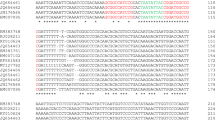Summary.
Tomato leaf curl virus (ToLCV) is a whitefly (Bemisia tabaci) transmitted geminivirus (family Geminiviridae, genus Begomovirus) causing a destructive disease of tomato in many regions of India, East Asia and Australia. While ToLCV isolates from Australia and Taiwan have a single genomic component (designated DNA-A), those from Northern India have two components (DNA-A and DNA-B). The ToLCV isolates from Southern India (Bangalore) previously cloned seem to have a DNA-A-like monopartite genome. We have used degenerate DNA-A-specific PCR primers to clone the genome of a ToLCV isolate (named ToLCV-Ban4) from field-infected tomato plants growing in Bangalore, India, in 1997. Degenerate DNA-B-specific PCR primers have not allowed to amplify a putative DNA-B from infected tomato, at the time when DNA-B fragments were amplified from plants infected by known bipartite begomoviruses. The full-length 2759 nucleotide-long DNA-A-like viral genome was sequenced. Similarly to other monopartite ToLCV and TYLCV isolates, ToLCV-Ban4 contains six open reading frames, two on the virion strand and four on the complementary strand. Sequence comparisons indicated that ToLCV-Ban4 is similar to the other three isolates from Bangalore previously sequenced, and is closely related to ToLCV-Ban2 (approximately 91\% nucleotide sequence identity). Phylogenetic analysis showed that the ToLCV isolates from Bangalore constitute a group of viruses separated from those of Northern India. ToLCV-Ban4 was detected in tomato and in its whitefly vector Bemisia tabaci by one or by a combination of ELISA, Southern blot hybridization and PCR. Parameters of virus acquisition, retention and transmission by the whitefly vector were investigated in the laboratory. Single whiteflies were able to acquire ToLCV-Ban4 from infected tomato and to transmit the virus to tomato test plants, but five insects were necessary to achieve 100% transmission. Minimum acquisition access and inoculation access periods were 10 min and 20 min, respectively. A latent period of 6 h was required for B. tabaci to efficiently infect tomato test plants. Following a 24 h acquisition access period the insect retained its ability to infect tomato test plants for 12 days, but not for its entire life. In one insect/one plant inoculation tests, female whiteflies were more efficient (∼95%) than males (∼25%) in transmitting the virus.
Similar content being viewed by others
Author information
Authors and Affiliations
Additional information
Received July 5, 1999 Accepted March 2, 2000
Rights and permissions
About this article
Cite this article
Muniyappa, V., Venkatesh, H., Ramappa, H. et al. Tomato leaf curl virus from Bangalore (ToLCV-Ban4): sequence comparison with Indian ToLCV isolates, detection in plants and insects, and vector relationships}. Arch. Virol. 145, 1583–1598 (2000). https://doi.org/10.1007/s007050070078
Issue Date:
DOI: https://doi.org/10.1007/s007050070078




